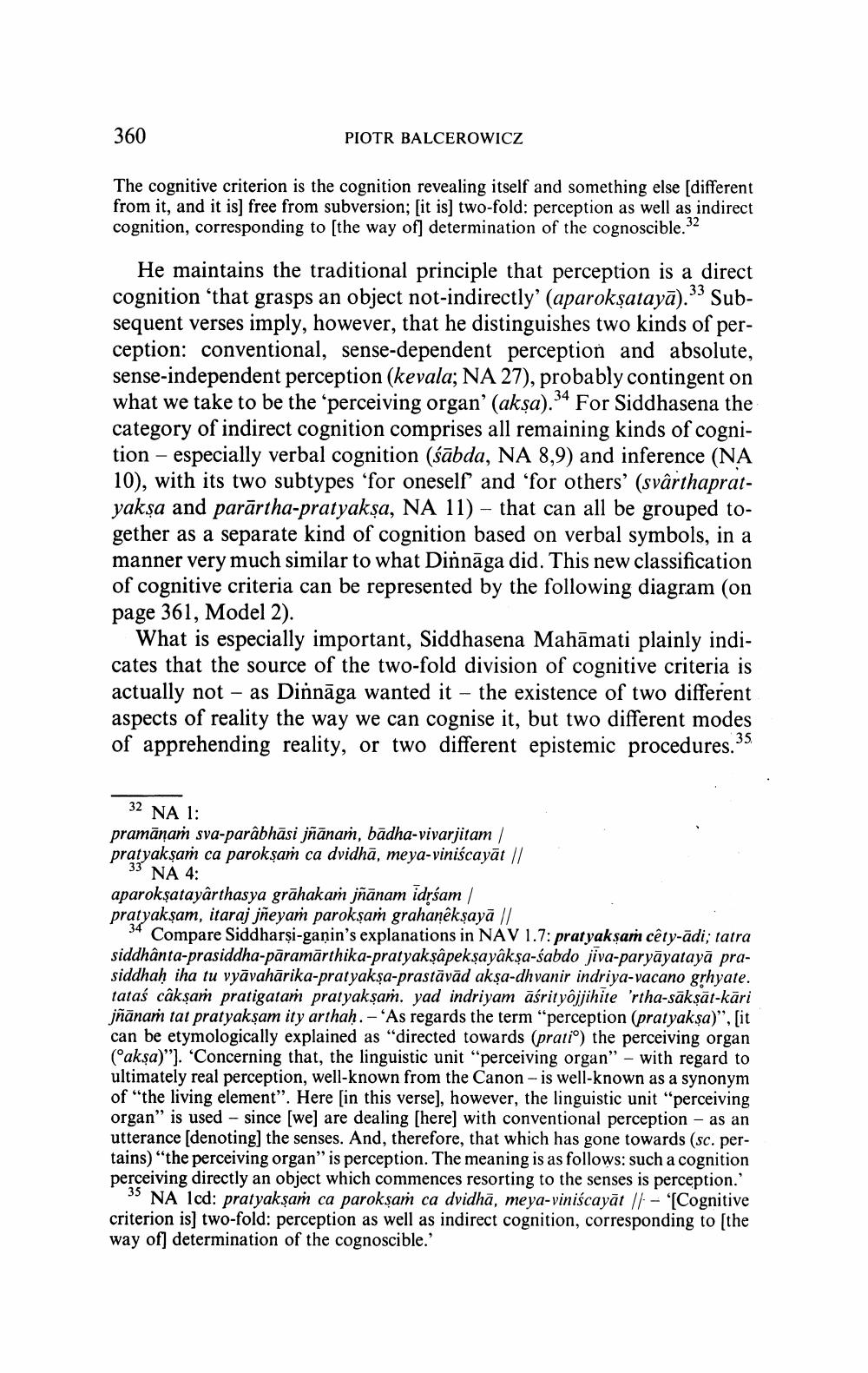________________
360
PIOTR BALCEROWICZ
The cognitive criterion is the cognition revealing itself and something else [different from it, and it is free from subversion; [it is] two-fold: perception as well as indirect cognition, corresponding to the way of] determination of the cognoscible.32
He maintains the traditional principle that perception is a direct cognition that grasps an object not-indirectly' (aparoksatayā).Sub sequent verses imply, however, that he distinguishes two kinds of perception: conventional, sense-dependent perception and absolute, sense-independent perception (kevala; NA 27), probably contingent on what we take to be the perceiving organ' (akşa). 34 For Siddhasena the category of indirect cognition comprises all remaining kinds of cognition - especially verbal cognition (sābda, NA 8,9) and inference (NA 10), with its two subtypes ‘for oneself and 'for others' (svârthapratyakșa and parārtha-pratyakşa, NA 11) - that can all be grouped together as a separate kind of cognition based on verbal symbols, in a manner very much similar to what Dinnāga did. This new classification of cognitive criteria can be represented by the following diagram (on page 361, Model 2).
What is especially important, Siddhasena Mahāmati plainly indicates that the source of the two-fold division of cognitive criteria is actually not - as Dinnāga wanted it - the existence of two different aspects of reality the way we can cognise it, but two different modes of apprehending reality, or two different epistemic procedures. 35
32 NA 1: pramānam sva-parâbhāsi jñānam, badha-vivarjitam / pratyakşam ca parokşam ca dvidhā, meya-viniscayāt //
33 NA 4: aparokşatayârthasya grāhakam jñānam idrśam / pratyakşam, itaraj jñeyam parokşam grahanêkṣayā //
34 Compare Siddharși-ganin's explanations in NAV 1.7: pratyakşam cêty-ādi; tatra siddhanta-prasiddha-pāramārthika-pratyaksāpekṣayakşa-sabdo jiva-paryāyatayā prasiddhaḥ iha tu vyāvahārika-pratyakşa-prastāvād akşa-dhvanir indriya-vacano grhyate. tataś câkşam pratigatam pratyakşam. yad indriyam āśrityôjjihite 'rtha-sākṣāt-kāri jñānaṁ tat pratyakşam ity arthah. - 'As regards the term “perception (pratyakşa)", [it can be etymologically explained as "directed towards (pratio) the perceiving organ (°akşa)"'). "Concerning that, the linguistic unit “perceiving organ" - with regard to ultimately real perception, well-known from the Canon - is well-known as a synonym of "the living element". Here [in this verse], however, the linguistic unit "perceiving organ" is used - since [we) are dealing (here) with conventional perception - as an utterance (denoting) the senses. And, therefore, that which has gone towards (sc. pertains) “the perceiving organ" is perception. The meaning is as follows: such a cognition perceiving directly an object which commences resorting to the senses is perception.'
35 NA Icd: pratyakşam ca parokşam ca dvidhä, meya-viniscayāt // - '[Cognitive criterion is) two-fold: perception as well as indirect cognition, corresponding to the way of determination of the cognoscible.'




